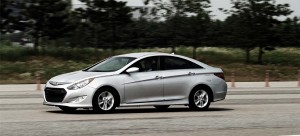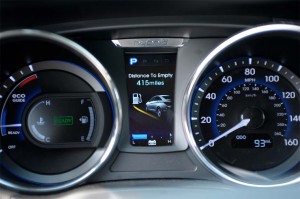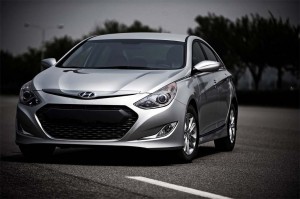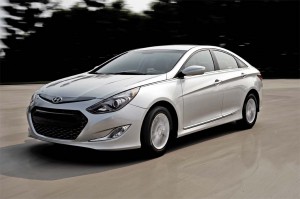Tap the “Start” button and an assortment of lights and gauges pop to life, but all in near silence.
As we slip the 2011 Hyundai Sonata Hybrid into gear and slowly squeeze the throttle, the sedan begins to creep forward, the tires crunching on the tarmac at the maker’s Namyang Proving Grounds, an hour outside Seoul.
Slapping the accelerator towards the floor, the 2.4-liter I-4 engine under the hood suddenly roars to life, the car launching aggressively down the pavement and hitting 60 in just over 9 seconds – not much off the time of the standard, gasoline-powered 2011 Sonata.
TheDetroitBureau.com braved the long flight over to Seoul, followed by the drive to Namyang to get an early drive in the 2011 Hyundai Sonata. Though it’s actually the second gasoline-electric model in the maker’s line-up, an earlier battery version of the Elantra has so far been offered only to domestic Korean buyers. The ’11 Sonata will be the first Hyundai hybrid earmarked for the U.S. – though as TheDetroitBureau.com also reports, it won’t be the last. (Click Here for more on Hyundai’s aggressive plans to expand its hybrid line-up.)
The conventionally-powered version of the 2011 midsize sedan, the seventh-generation Sonata, is quickly proving to be a smash hit for the Korean carmaker – “the most highly-rated model we’ve ever seen,” according to George Peterson, of the consulting firm, AutoPacific, Inc. But the Sonata line is about to grow, with the addition of both a 2.0-liter turbo and the new Sonata Hybrid.
Already a striking design statement, the gas-electric model is even more visually distinctive, with a blacked-out hexagonal grille, unique head and taillamps and extensive aerodynamic revisions that reduce the Sonata’s drag coefficient from 0.28 to 0.25. (To put that into perspective, this roughly 10% reduction in wind resistance is itself responsible for boosting fuel economy by 5%, according to Hyundai engineers.)
The new Blue High-Tech system has some technological differences from existing hybrids, as well. To start with, Hyundai has adopted a manganese-doped lithium-polymer battery pack, rather than nickel-metal hydride batteries. That helped the maker reduce both the size and weight of the pack by about a third even though the lithium batteries will hold about 15% more energy.
Lithium-ion, a variation of Hyundai’s polymer battery, will only begin showing up later this year on even more advanced plug-in hybrids and pure battery-electric vehicles.

Though it won't have final numbers until just before sales launch, Hyundai expects the 2011 Sonata Hybrid to deliver at least 40 mpg.
Another key difference between the Sonata Hybrid and, say, the Toyota Prius, the world’s most popular gas-electric model – is in the transmission. Existing gas-electric models have relied on modified continuously variable transmissions to smoothly blend the power of an electric motor and a gasoline engine.
Hyundai has opted to use a 6-speed automatic transmission, conventional but for the lack of a torque converter. It has taken some significant developments in electronic engine and transmission control technology to make this possible, stressed Senior Vice President Kim-Sang Lee, without the car lurching every time one source of power or the other is turned on or off.
And, indeed, as we race around the Hyundai Proving Grounds, there is no discernable sensation as the 2011 Hyundai Sonata Hybrid goes from electric to gas to gas-electric mode, other than what we can hear coming from under the hood.

The gauge cluster on the 2011 Hyundai Sonata Hybrid will offer the obligatory aids to help motorists boost fuel economy.
The use of a step transmission has several advantages, claims Lee. For one thing, there’s the familiar sensation of running through gears, rather than the rubber band-like feeling associated with CVTs, such as the Toyota Synergy Drive system, that so many motorists find disconcerting.
There’s also the matter of cost. Hyundai won’t discuss hard dollars but claims its hybrid system is substantially less expensive than a CVT-based design.
Though the price tag won’t be announced until closer to launch, John Krafcik, CEO of Hyundai’s American subsidiary, hints at a number somewhere around $25,000, and that doesn’t include a roughly $5,000 federal tax credit Sonata Hybrid buyers will likely be eligible for.
As for fuel economy, the Hyundai hybrid will have several different selectable driving modes, one emphasizing performance, another “Blue” mode for maximizing mileage – which the maker now expects to come in at around 40 mpg, or a full mile per gallon more than it originally predicted during the global debut of the 2011 Hyundai Sonata Hybrid at the recent New York Auto Show.

The 2011 Hyundai Sonata Hybrid boasts a distinctive grille to help immediately set it apart from other versions of the midsize sedan.
That compares with 34 mpg for the similarly-sized Toyota Camry and 36 mpg for the Ford Fusion Hybrid.
Our all-too brief experience behind the wheel of a Sonata Hybrid prototype was impressive, and suggests it will offer similar driving dynamics to the conventionally-powered Sonata sedan. But we’ll wait until we clock more driving time before declaring that our formal conclusion. Stay tuned, as we expect to have a more extensive review before the 2011 Hyundai Sonata Hybrid rolls into U.S. showrooms.

